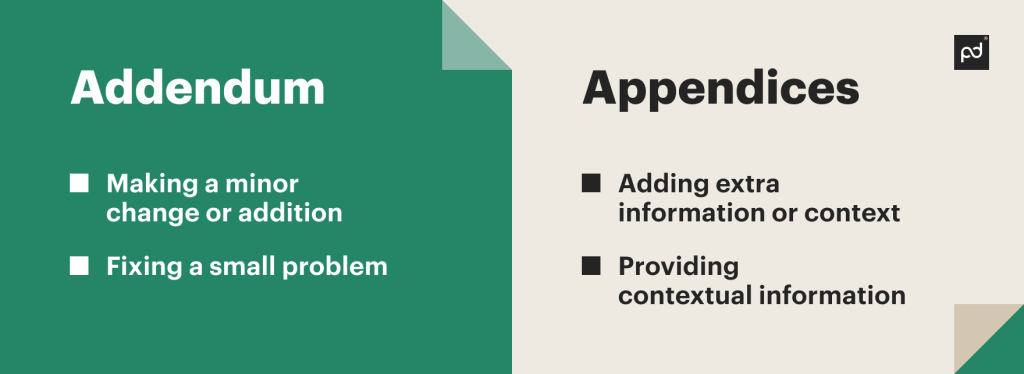
You’ve got a contract and want to add to it, but you’re stuck trying to figure out the differences between an addendum vs. appendix — and which one of the two you need.
It’s a relatable struggle, so let’s explore both terms at length below.
Manage all elements of your contract with PandaDoc
Before we get into the intricacies of appendices vs. addendums, it’s important to understand what these terms mean
An addendum is an extra clause, clarification, or piece of information that’s added to an existing contract.
For example, you could use an addendum to fix a loophole in the original or to explain something confusing.
For tips on how to write an addendum, check out our guide.
An appendix is a piece of supplementary material included with a contract.
It doesn’t contain any clauses or items that are vitally necessary to understand the document but rather information that enhances the main body of the contract.
For example, an appendix for a contract detailing the terms of a collaborative project might include a schedule.
While the contract would make sense without it, the schedule provides context and creates a clearer image of what the proposed project will look like.
While they both add to the main body of a contract or legal document, an appendix and an addendum aren’t the same thing.
Here are some of the main differences between them.
Even after a contract has been finalized, you can create addendums to it, provided all parties agree to them.
This includes addendums created months or years after the initial contract was drafted.
That’s not the case for an appendix.
Appendices must be created at the same time as the contract and are almost always included with it.
An appendix exists to supplement what’s already in a contract, but it can’t change its terms.
For example, you might include a schedule or glossary in an appendix but not a new clause.
However, actively amending a contract is possible with addendums, which let you add to the existing terms.
For instance, if your contract previously said something like ‘Neither party will profit from the agreement’, you could add an addendum that says ‘Including by selling or promoting the partnership described’.
This type of change allows you to be more specific.
In the case of addendums, consent most definitely matters.
Since they have the potential to affect or even alter some of the terms of a contract, they can’t be okayed by only some of the parties they affect.
Rather, you have to get the go-ahead from everyone before adding them to a contract.
While it might contain interesting or relevant details, you can technically read a contract without its appendices and still understand it.
That’s not always the case with addendums.
This is because an addendum has the potential to change the terms of the contract to some extent.
So, while you can theoretically skip the appendix, you should always pay close attention to addendums.
Next, we’ll cover when you might want to use either an appendix or an addendum.

Your contract is finished and looking good in that it’s legally binding and covers all your bases.
However, it relies on some highly technical language that your average layperson — or even professional — might have to look up.
You could save them time by including a list of definitions as an appendix since this would add extra information that helps the contract make sense to the average reader.
Think of this use case as being a little like stapling an extra piece of paper to the back of a printout.
While it seemed to include as much information and detail as it needed to, you’ve recently discovered your contract has a loophole or two.
Instead of drafting a new one or making a major change, you can use an addendum to make a minor adjustment.
This lets you create contract variations that benefit all parties. It also saves you from having to start over.
If you’ve got extra information that’s relevant but not strictly necessary, it can also find a place in the appendix.
This could include bonus facts that create a richer backdrop, details that don’t need to be included but do add interest, or other supplementary information.
Provided an issue is minor, you can patch up existing contracts with an addendum too.
Think of them like band-aids for small cuts or a patch of cloth that repairs a tear.
If the wound is too big or the clothes too torn, however, you may have to create a new contract instead.
While it’s important to understand the distinctions between an addendum and an appendix, it’s equally crucial to make sure you know how to create these add-ons.
That’s where PandaDoc comes in handy.
Thanks to our purpose-built contract management software, you can quickly draft any additions you require.
Plus, our large array of templates will help you figure out how things should look and which elements need to go where.
In short, PandaDoc helps you whip up the perfect contract add-on every time, regardless of the specific addition you’d like to include.
PandDoc is not a law firm, or a substitute for an attorney or law firm. This page is not intended to and does not provide legal advice. Should you have legal questions on the validity of e-signatures or digital signatures and the enforceability thereof, please consult with an attorney or law firm. Use of PandaDocs services are governed by our Terms of Use and Privacy Policy.
Olga Asheychik Senior Web Analytics Manager at PandaDoc
Olga is a Senior Web Analytics Manager at PandaDoc who has been working in the Digital Marketing field for the past 15 years. Olga had roles driving marketing campaigns in document automation, contracts, invoices, and agreements. In her daily life, she is a big fan of traveling and connecting with new people.



Subscribe to get our most-popular proposal eBook and more top revenue content to help you send docs faster.